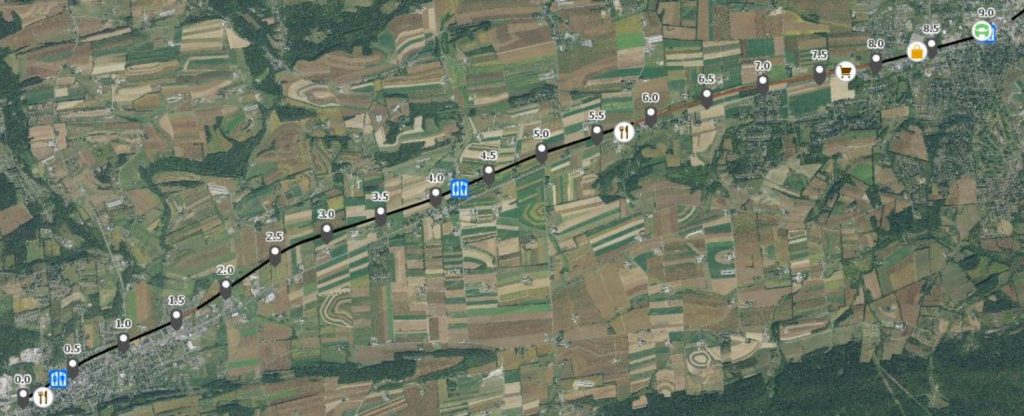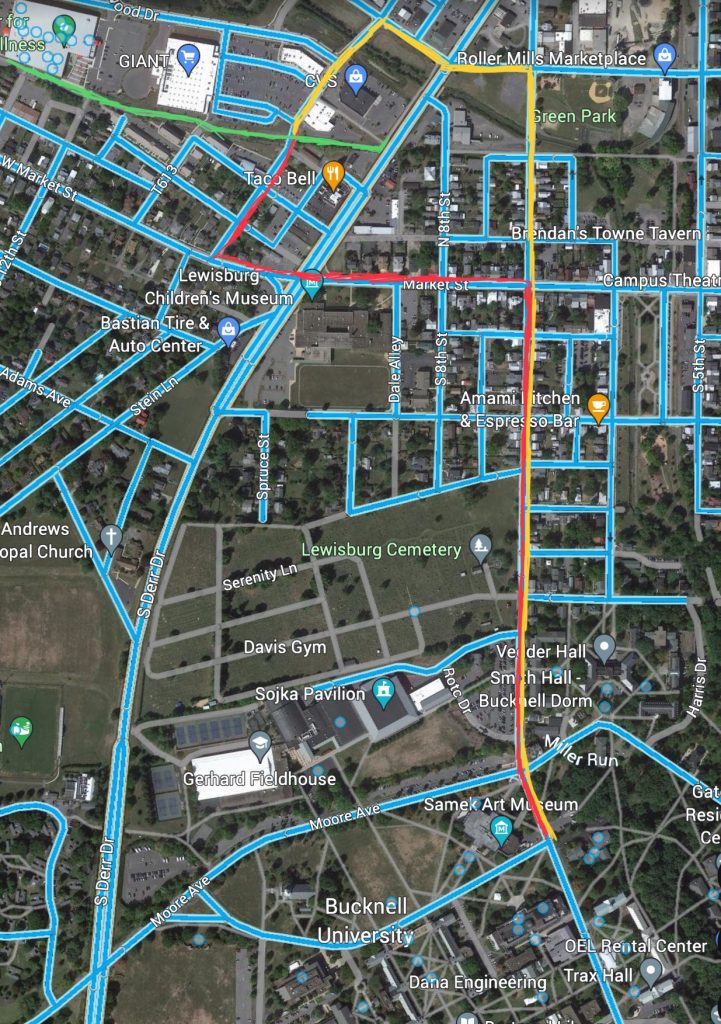Green Across 15: Bucknell’s Restoration Takes Hold
Driving into the Bucknell campus from Route 15 is an experience that juxtaposes nature’s beauty with human architectural development. The lush, green trees and plants alongside the iconic Bucknell sign welcome visitors, while the imposing stadium stands as a testament to the University’s athletic prowess. However, on the other side of Route 15, amidst the cacophony of the construction of the newest dorm buildings, lies a hidden gem – a thriving, diverse ecological community – that shows the opportunities for ecological restoration along the greenway on west campus.

As you cross Route 15 and follow the road down to the golf course you will find yourself at the driving range where you are greeted by a gorgeous view of the meadow, across Smoketown Road from the greenway corridor. Professor Chris Martine, an advocate for conservation, acknowledges that “we have so much space out there that it’s nice to sort of maybe create some additional habitat.”
“We wanted to see if facilities, if at all possible, could be very innovative and set aside a portion of campus for meadows. There are almost no meadows left in the world. And meadows are critical habitat for a lot of things.” explains Professor Benjamin Hayes.
The health of a wildlife community relies on a foundation of native insects. When these insects thrive, they attract insect-eating birds. These birds, in turn, carry seeds of larger plants, creating new habitats and food sources for mammals. Even a small increase in native insects can trigger this domino effect, building a more diverse ecosystem over time.

Hayes’ idea for creating a meadow began the focus on restoration efforts across Route 15, spearheaded by the collective endeavors of students, faculty, staff, and various organizations. Participants have worked hard to monitor water quality, develop models, and more to ensure the positive development of the restoration efforts. Students have gone as far as developing their thesis on the restoration across Route 15 and have dedicated their time at Bucknell to ensuring its continued success.
In the meadow across 15, they have seen a boom from beetles, spiders, and grasshoppers to deer, and even a pair of foxes! “We’ve monitored, we’ve mapped the amount of aquatic habitat both in the channel and on the margins of the channel like here. As well as our terrestrial habitat. And we’ve seen over 600% increase in habitat for turtles and frogs and amphibians. We’ve seen an 8,000 percent increase in the beetles and the spiders and the grasshoppers,” emphasizes Professor Hayes showcasing just how successful the restoration has been at the meadow.
The funding for the restoration came from a grant from the Pennsylvania Department of Environmental Protection that gave several hundred thousand dollars to Bucknell to complete this restoration. This funding was vital in the betterment of restoration and allowed for important developments to be displayed.
Restoration efforts are no small task and money alone will not fix the issue. There are plenty of organizations working diligently to provide any support they can. The Chesapeake Conservancy and other local conservation groups work together to provide native shrubs and trees along with aiding in their planting. The Susquehanna Greenway Partnership, Maryland Conservancy, Buffalo Creek Conservancy and more also work on this project to help restore the Bucknell campus.
Moreover, the restoration initiative serves as an educational tool, offering opportunities for experiential learning to both Bucknell students and the broader community. Professor Martine envisions restoration education using outdoor habitats. “So if you create these little bits of restored habitat, they can be places where we can teach Bucknell students, we can teach local K-12 students. People can learn if there’s good signage or other things related to, you know, QR codes that go to cool resources,” he explains.

As with all restoration, there will always be more to do. For example, there are several invasive species inhabiting the meadow including thistle and Bradford pairs. By including students and utilizing volunteers, the meadow will continue to be a thriving success story that participants such as Professor Hayes could go on about for a lifetime.
Overall, with the combination of both improving Bucknell’s ecosystem and restoring it to what it once was along with educating the public, it acts as a win-win for both the animals and the educated. By investing in the restoration of natural habitats, Bucknell University not only enhances biodiversity but also cultivates a generation of environmentally conscious citizens.
Bridging the Bucknell Divide: a Greenway to Community Connection
One of Bucknell’s strengths as a campus is its spacious green areas which provide a window for fresh air and outdoor activities to the whole Lewisburg area. However, in the past, there has been a lack of connection between the larger community and the lack of green spaces.
There are many locations for outdoor activities that a person could partake in year-round, and at the heart, there are the Bucknell Greenway and the Union County Rail Trail. A greenway is a place for biking, walking, skating, rollerblading and just enjoying nature in general.
As a vocal supporter of greenways, Mayor Kendy Alvarez describes them as “a fantastic resource and tool for our community.” Mayor Alvarez is a Bucknell Alumni from the class of 2006 and is known locally as a fixture of the Borough. From her commitment to her peers during her time at Bucknell to her dedication to the community Mayor Alvarez enthusiastically advocates for all walks of life according to her supporters.
In a landscape dominated by car culture, Mayor Alvarez stated that the pathways offer a refreshing alternative, prioritizing pedestrians and cyclists, fostering a sense of connection, and encouraging a healthier way of life.
The Bucknell Greenway snakes its way through the university grounds and offers students a wonderful means of being active and connecting with nature. Among the leaves and chirping birds, the greenway allows anyone to recharge and reconnect with nature in this technologically immersed society.

Additionally, the Union County Rail Trail creates a network of trails that reach from here to Mifflinburg and more. Connecting both the Bucknell Greenway and the Union County Rail Trail would forge a deeper connection with the local community explains Mayor Alvarez and others interviewed.
A greenway is more than a path but is a connection between communities. By providing a safe and accessible space for outdoor recreation, individually the two local pathways encourage appreciation of the natural world and foster a sense of responsibility toward its preservation. Connecting these two pathways would amplify the sense of freedom and exploration of the surrounding area
With its educational components, the connection between the two pathways could provide ample opportunities for learning and reflecting. Professor Martine explains that “the idea that people could walk on our greenway and see this working farm run largely by students could really inspire people to, you know, think about where their food comes from.”
Many people currently explore both the Bucknell Greenway and the Union County Rail Trail but are inhibited from using them together because the Trail is split by Route 15 and the Greenway is still separated from the Lewisburg community. The traffic along Route 15 provides a dangerous crossing for pedestrians who may be trying to visit destinations on the other side.
When questioned, many Bucknell students and staff stated that utilizing the preexisting underpass on campus – which currently connects the newly developed west apartments to the rest of campus – would be an option. But when trying to find a connection closer to the Giant shopping center shopping center a variety of issues arise.
Without a designated connection between the two pathways, Mayor Alvarez emphasized “The reality a lot of people and I often see is that they’re crossing where they’re not supposed to. There are signs that tell you not to cross.”
The Borough of Lewisburg researched several options for connecting the two, including an underpass or an overpass. However, their research found that the project would be too costly and create accessibility issues due to the needed grade of incline/decline. Instead, the Borough decided that an at-grade crosswalk would be the best option, as it would be the least invasive and most cost-effective.
However, a fight like this cannot be fought alone. Since Route 15 is a state road, the Pennsylvania Department of Transportation (PennDOT) would need to install the crosswalks. By sending emails, letters, and making calls to public officials and representatives about building infrastructure to connect the Bucknell Greenway and the Union County Rail Trail, everyone could come together as a community to make being outdoors a safer, more enjoyable experience.

Here is a current path lined in red used by a Bucknell staff member who walks to Giant walking down 7th street, making a left onto Market Street, crossing Route 15, and finishing their walk by taking North 10th Street the rest of the way. As a student, this reporter believes that taking 7th Street all the way down to St Mary Street and then across to the other side of 15 you could take North 10th Street to the Union County Rail trail where you can then safely enjoy the outdoors. This path is outlined in yellow and would be optimal for those riding bikes. Both paths lead to the Union County Rail Trail in green (seen in the top right of the screenshot from Google Earth) and start from the Elane Langone Center.
When it comes to directly linking the Greenway and the Trail, the borough is working on connecting the campus to the Trail along 6th Street and the park corridor there.
As the call of the outdoors continues to resonate, the paths around play a pivotal role in shaping the future Mayor Alvarez and Professor Martine note. For these two long-time Lewisburg residents, the developing local greenway system represents a commitment to sustainability, a celebration of community, and a gateway to a healthier, more vibrant way of life. By venturing onto these pathways, students, residents, and visitors alike can embark on a journey of discovery – a journey that leads not only to new places but also to a deeper understanding of themselves and the world around them.
Recommended Reading:
- Susquehanna Greenway Website
- Chesapeake Conservancy Website
- Maryland Conservancy Website
- Lewisburg Borough Website
- Miller Run Symposium Handout (Benjamin Hayes)
- Restoring Miller Run (Benjamin Hayes)
